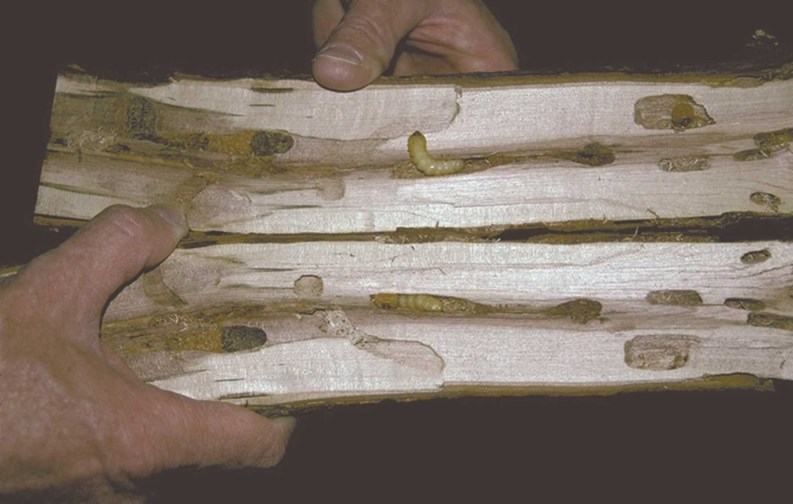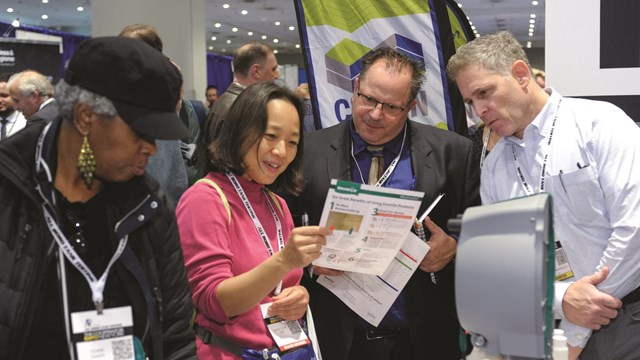It’s like something from a horror movie: a six-legged invader arrives in New York, stowed away in wooden shipping crates from Mainland China. Once ashore, the creatures fan out, looking for food. The beast has no natural predators here, and is immune to all known poisons. It is tough, it is tenacious, it is borderline indestructible…and it’s hungry. The target of its hunger are hardwood trees, and it attacks them without mercy, killing them from the inside out.
The invader is not a genetically enhanced mutant, or an escaped government super-agent gone rogue—it’s a bug. Specifically, the Asian Longhorned Beetle, or ALB. The areas already infested include New York City, Long Island, Massachusetts, and, yes, New Jersey. The known infestations have been destroyed for now, but that doesn’t mean that the Asian Longhorned Beetles won’t return like the evil creatures in a horror movie, for your HOA’s trees.
Weird Science
The Asian Longhorned Beetle—anoplophora glabripennis, if you’re an entomology buff—hails, as the name suggests, from eastern Asia. The Chinese call it the sky oxen beetle, and sometimes it’s referred to as the starry night beetle on account of its distinctive markings. It’s relatively large—over an inch long—with a black shell highlighted by irregular white blotches and knobby, segmented antennae that can be twice as long as its body. It’s relatively handsome, as insects go, but its food of choice is deciduous hardwood trees—especially poplars, willows, elms, birches, and especially maples—and that dietary habit has disastrous effects on the trees themselves.
“The beetle grows from egg to larvae to adult,” explains Bill Carolan, owner of The Exterminator, a pest control company based in Toms River. “The larvae are what eat all the wood and kill the trees.”
During the summer breeding season, says Carolan, the female beetles use their mandibles to carve out pits in a host tree’s bark, where they lay their eggs. A single beetle creates up to 50 such depressions in the tree—a swarm of beetles can riddle a tree with damaging, moon-like craters.
After about two weeks, the eggs hatch and the larvae tunnel deep into the tree’s heartwood, sucking out the nutrients, and sapping the life from their host. Once deep inside, they stay dormant until the following winter, when they hatch as adults. In the late spring, they eat their way back out of the tree, leaving one of the telltale signs of ALB infestation—perfectly circular holes about the size of a dime—and further damaging the already weakened tree.
According to a press release circulated by the New Jersey Department of Agriculture (NJDA), “The beetles will colonize a tree until it is so riddled with tunnels that it becomes dangerous, as limbs and branches may fall onto passersby. Once a tree is infested, no pesticide treatment is effective and the tree must be taken down. In addition, any nearby host trees also must be removed to ensure that the beetle has not infested them as well.”
Warning Signs
So how do you know if your association’s trees are under attack from the speckled marauders? Obviously, the first warning sign is sighting the beetle itself. If you suspect your tree of being a breeding ground for the Asian Longhorned Beetle, notify the authorities immediately (see sidebar).
According to Jeffrey Beach, an NJDA spokesperson, “The very first thing a condo association member or a homeowner should do [if they spot a beetle or evidence of infestation] is contact the NJDA.
“The second thing homeowners should do is immediately stop all movement of wood onto or off of their properties. The beetle can easily go unnoticed if it burrows into a big log. Moving infested firewood into an uninfested area is the fastest way to spread the beetle’s territory.
These variety of beetles have the ability to fly a quarter of a mile away in search of a host, but once they find one, they are homebodies, preferring to lay eggs in their own host tree. Only when the tree itself dies do they move. This tendency gives professional exterminators the chance to destroy them more easily—but it all depends on how quickly their presence is discovered and how quickly steps are taken to eradicate them.
“[It’s vital] to be as proactive as possible about alerting all residents in your community and those nearby to be on the lookout for the bee,” says Beach. “In the Middlesex/Union infestation, we went on television when we had only one known infested tree in Carteret. A woman across town saw the TV piece, recognized the beetle as one she had seen near her home, and called us. The infestation near her home on the Carteret-Rahway border was much, much larger than anything else we found in that area. Her call probably saved us months of searching for the extent of the infestation, which would have given the beetle months more to spread even further.”
According to the USDA, another symptom of beetle infestation is sap oozing from the aforementioned round exit holes in the tree; the arboreal equivalent of bleeding. The beetles’ boring activity also leaves behind piles of sawdust mixed with their own waste; this mixture is called frass, and it can be found on tree trunks and in untidy heaps around the base of infested trees.
Finally, and most conspicuously, if the limbs of your tree suddenly look sickly and even start to fall off, even though there has been plenty of water, you have a problem.
A Migrant’s History
The federal government, working with zoologists at the University of Vermont, has prepared a report with FAQ on the Asian invaders.
According to the report, “The beetle is native to China and Korea. It causes major damage of poplar plantations in China, where they are unable to control this pest.”
The report goes on to say that the first identified infestation was in Brooklyn, New York in August 1996, and that the beetles likely arrived in wood pallets shipped from China in the late 1980s. In September 1996, an infestation was also found in Amityville, New York, and since then, infestations have been reported all along the Eastern seaboard. Separate infestations were to blame for breakouts in Islip on Long Island, in Queens, and in Central Park. Some 6,000 trees had to be destroyed in New York alone. Other infected areas include Chicago; Worchester, Massachusetts; Toronto; and in New Jersey, in both Jersey City and Carteret. In the Garden State, over 23,000 trees have had to be destroyed to contain the insects.
According to Beach, “The ALB has been declared eradicated from the first Hudson County infestation, because five years of surveys after the initial tree-cutting in 2002-03 showed no new signs of the pest. Tree cutting has been completed in the second Middlesex and Union County infestation and surveys continue there to ensure that the beetle doesn’t reestablish itself. However, New Jersey residents shouldn’t think that means there’s no chance of the beetle showing up again. DNA testing showed us that the beetle was in Middlesex/Union for six years or more before it was found by a resident in 2004. So, vigilance is always the key.”
In Treatment
Unlike other insects, these particular beetles seem to be immune to poisons. “No chemical or biological control methods are currently known,” the UVM report states, “although the U.S. Department of Agriculture’s Animal and Plant Health Inspection Service is conducting experiments testing the effectiveness of some insecticides.”
The only way to get rid of the pests is to quarantine the host trees and burn them; fire is the only known killer of the pest.
New Jersey has a number of government agencies on hand to help. The Garden State’s policy now involves chopping down all healthy trees of the host species within an eighth of a mile radius of the infested trees.
In Hudson County in 2002 and again in Middlesex/Union 2004, the New Jersey Department of Agriculture took the strongest possible approach toward eradication,” says Beach. “All known infested trees and all high-risk potential host trees—like maples—within certain distance of known infested trees were removed. In Hudson County, that meant about 400 trees, but in Middlesex/Union, it was well into the thousands because of the larger extent of the infestation.”
In addition, U.S. Customs rules were altered a decade ago with respect to wooden shipping crates, to ensure that no new beetles would make the trip from China or Korea. Today, government research agencies in both the U.S. and Asia are working on other possible ways to eradicate ALB infestations, according to the NJDA.. These methods include introducing parasitic wasps into beetle-infested areas that will in turn attack the beetles and their grubs. Also being explored is the idea of introducing microscopic organisms called nematodes that like to prey on beetles, or interrupting the beetles’ breeding cycle at some vulnerable point along the line.
Trees are some of an association’s most valuable landscaping assets—they provide shade, act as windbreaks, freshen the air, and are beautiful to look at. They also represent a major commitment in terms of both expense and cultivation. It can take decades for a tree to reach its full potential, so to lose even one is a blow to any community.
“Obviously, cutting down that many trees upsets residents and local officials,” says Beach, “but we found that if we took the time to explain the reasoning behind the wider cutting—at public meetings and through numerous press events—that people understood it was better to deal with the problem once. By removing high-risk host trees as well as infested trees, we avoided having to come back in a year or two and do it all over again. In fact, some “high-risk host” trees were actually found to be infested once they were cut down and chopped open. To help people cope with the loss of trees, we worked with state and federal forestry agencies to replace as many of the trees as possible with varieties the beetles don’t infest, like oaks.”
To prevent the wholesale deforestation of your building or HOA’s grounds, it’s vital that residents, staff members, and managing agents stay vigilant and keep a watchful eye out for signs of the Asian Longhorned Beetle. It may be small, but the damage it can do to your association is a very big deal.
Greg Olear is a freelance writer and a frequent contributor to The New Jersey Cooperator.





Leave a Comment